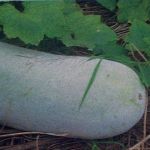| Common Name: |
Ash pumpkin |
| Other Names: |
White gourd, Wax gourd, winter melon |
| Botanical Name: |
Benincasa hispida |
| Genus: |
Benincasa |
| Family: |
Cucurbitaceae |
| Cultivation: |
Well-drained, rich soil in sun, with ample water. |
| Propagation: |
By seed sown in spring at 18°C (64°F). |
| Harvest: |
Fruits are picked as required. Seeds and rind from ripe fruits are dried for decoctions. |
| Native Location: |
Tropical Asia and Africa |
| Height: |
6m (20ft) |
| Hardiness: |
Min. 16°C (61°F) |
| Parts Used: |
Fruit rind (dong gua pi), seeds (dong gua zi or dong gua ren) |
| Properties: |
A cooling, pleasant-tasting herb that has diuretic effects (fruit rind), is anti-inflammatory and expectorant, and lowers fevers (seeds). |
| Medicinal Uses: |
Internally, in Chinese medicine, for urinary dysfunction and summer fevers (rind); cough characterized by thick phlegm, internal abscesses, and vaginal discharge (seeds). Internally, in Ayurvedic medicine, for epilepsy, lung disease, asthma, coughs and hiccoughs, urine retention, internal hemorrhage (fruit); diabetes (rind), tapeworm (seeds); as an antidote to poisoning from mercury, alcohol, snakebite, and toxic plants (fresh juice). |
| Culinary Uses: |
Mature fruits are eaten raw or cooked as a vegetable, especially in curries, or made into sweet pickles, preserves, and candy. They are the main ingredient in tung kwa chung (water melon pond) a classic Chinese dish in which the fruits are de-seeded and filled with soup before steaming. Immature fruits, young leaves, and flower buds are stir-fried or steamed. Ripe fruits are candied, often as an adulterant of citron. Seeds are eaten fried or roasted. |
| Economic Uses: |
Wax is scraped from the rind to make candles. |
| Bibliography: |
Encyclopedia of Herbs by Deni Brown. Copyright © 1995, 2001 Dorling Kindersley Limited. pg 142
|

